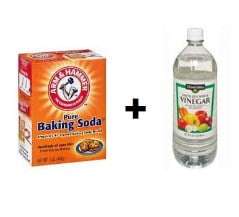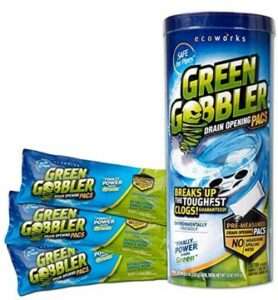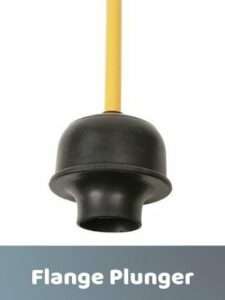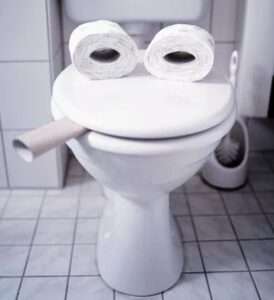Most people have encountered the uncomfortable scenario of having their fecal matter lodged in the toilet bowl or facing a clogged toilet after using it.
Despite the unpleasantness and dread that comes with this experience, the act of flushing away the waste doesn’t have to be arduous or discomforting. With some basic techniques and without requiring any specialized plumbing knowledge, anyone can resolve a clogged toilet issue.
This article aims to offer comprehensive guidance, presenting a variety of effective and easy-to-execute solutions that have successfully unblocked innumerable obstructions and dissolved even the most challenging obstacles.
How to Dissolve Hard Poop in the Toilet: 6 Ways
- Use of Baking Soda and Vinegar to Break Down Poop
- Enzyme waste removal products to Dissolve Hard Poop
- Use a Toilet Plunger
- Toilet Auger for a Clogged Toilet
- D-I-Y with a Clothe Hanger
- Detergent and Hot Water
1. Baking Soda and Vinegar

The combination of vinegar and baking soda is a proven and safe household agent that is particularly useful in situations where a plunger is unavailable or misplaced.
This powerful duo is also highly effective in cleaning surfaces and eliminating unpleasant odors, making it an ideal solution for removing clogged drains caused by grease.
When it comes to removing stubborn poop from a clogged toilet bowl, the process is simple and hassle-free. Begin by adding 240 ml of baking soda to the toilet bowl and allowing it to sit for a minute or two. Next, slowly pour 3/4 glasses of vinegar into the bowl, being careful not to overflow the toilet.
The combination of vinegar and baking soda will produce a fizzy chemical reaction that will dissolve the obstruction over several minutes. Once the reaction has subsided, flush the toilet to see if the poop has disintegrated or loosened up, allowing it to flow freely through the plumbing system.
This method is a quick and easy alternative to using a plunger, and it is also a safe and non-toxic way to clean and deodorize your toilet bowl.
2. Use of Eco-friendly Products that dissolve poop
Based on my professional experience, I have found that one of the most effective and hygienic methods to dissolve fecal matter that is stuck in a toilet is through the use of enzyme waste removal products. These products offer a straightforward and uncomplicated solution to address this unpleasant issue.
In the event of a toilet blockage, enzyme waste removal products offer an easy-to-use option. By following a simple step-by-step guide, one can effortlessly unclog their toilet in no time.
When selecting a product, it is important to consider the blend of enzymes that have the ability to liquefy waste material by breaking it down, as well as its drain-clearing capability.
Furthermore, choosing an eco-friendly product that is not detrimental to the toilet bowl and pipe system and is less harmful to the environment is always recommended.
First, measure the recommended amount of the Toilet Clog Remover. (See the product below)
To address a clogged toilet, pour the appropriate solution into the bowl and allow 4 to 6 hours for the enzymatic agents to break down the obstruction. Once the obstruction has been disintegrated, the toilet may be flushed to expel the waste.
Green Gobbler DRAIN OPENER PACS – Best Toilet Clog Remover

- EFFECTIVE AGAINST: Toilet Paper, Organic Materials, Hair, Flushable Baby Wipes, Soap Scum & more.
- ENVIRONMENTALLY FRIENDLY and BIODEGRADABLE.
- Easy to use.
3. Use a Plunger

While it may appear rudimentary, possessing a plunger at home is essential in maintaining proper toilet functionality. In fact, plunging is the most straightforward, hygienic, and efficient approach for remedying a severely clogged toilet that refuses to flush.
There are two primary types of plungers available: one specifically designed for unblocking shower drains, and the other known as a flange plunger, ideally suited for unclogging toilets.
To successfully plunge a toilet, begin by safeguarding your hands against bacteria by wearing rubber gloves. Carefully position the flange plunger within the toilet bowl.
Using gentle pressure, start by slowly pushing and pulling the plunger up and down. Avoid excessive force, as this may result in unclean water spilling onto the floor or on yourself.
Next, create a vacuum by establishing a firm seal around the exit hole of the bowl. While maintaining the seal, slowly and steadily pump the plunger up and down. This technique helps prevent airlocks from forming.
It is advisable to repeat this process multiple times, ending with a sharp, final pull that will dislodge the clog and allow the water to run freely down the drain. These steps may be repeated as needed until the blockage is resolved, while attempting to flush the toilet.
Recommended:- 5 Toilet Plungers in 2022
4. Toilet Auger for a Clogged Toilet
The Toilet Auger is a purpose-built tool equipped with a medium-sized cable to effectively navigate through the toilet trapway, facilitating the elimination of any form of clog or obstruction. The device functions by either fragmenting the clog into smaller parts or gripping it firmly for effortless extraction.
The product features a hollow tube containing a rotating cable covered with a soft rubber sleeve that protects the porcelain bowl from unsightly scratches due to multiple pulls and pushes. With this device, you can effectively clear any hard clogs by smoothly snaking through the toilet drain, ensuring an unobstructed flow of water.
In conclusion, the Toilet Auger is an indispensable tool for any home or establishment plagued with stubborn toilet clogs. Its design and functionality are second to none, making it a must-have item for every household.
Read:- 5 Toilet Auger in 2022
5. The D-I-Y Drain Snake Using a Hanger
It is noteworthy that some individuals may find the entire process distasteful. However, for the process to be successful, a cloth hanger and pliers will be necessary.
To begin, cut one side of the hanger and use the pliers to straighten the wire. Proceed to form a medium-sized hook on one end of the wire and wrap the hook with a piece of cloth to prevent any damage to the toilet porcelain.
Wearing gloves, insert the wire into the bowl drain, and move it in and out while twisting it in a circular motion.
In the event that you encounter any obstruction within the toilet trapway, attempt to dislodge it by pushing the wire against it until the water starts to flow out.
6. Detergent and Hot Water
The following is a detailed explanation of the synergistic effects of hot water and dishwasher detergent when unclogging a toilet. Firstly, it is recommended to place five liters of water in a pot and cover it with a lid to expedite the heating process.
Subsequently, the dishwasher detergent can be poured into the toilet bowl. In the absence of dishwasher detergent, bar soap can be utilized by cutting it into small pieces and depositing them into the toilet bowl.
The mixture of hot water and detergent should be allowed to settle for approximately fifteen to twenty minutes before pouring it into the clogged toilet bowl.
The blend of hot water and detergent acts by loosening and dissolving the clog, thus facilitating the unclogging process. Once the solution has been poured into the toilet bowl, the toilet can be flushed without any obstruction.
With all things considered
Based on the aforementioned factors, it is recommended that each household possess a toilet auger and plunger to deal with any potential inconvenience that may occur.
Please refer to these helpful evaluations of toilet augers and plungers. The occurrence of a blockage caused by fecal matter or an overflow can induce anxiety in those who utilize the bathroom on a daily basis.
By employing these plumbing methods, one can effectively prevent a clogged toilet and eliminate overflowing toilet bowls.
Related Posts:-
Toilet Drains Slowly – 7 Simple tips & Trick
Can a drain auger unclog a toilet
No! and here is why…
There are two types of augers, toilet and drain auger. Each is designed for a specific task.
Firstly, let’s look at the drain auger. This tool is effective and useful for removing blockages and sediments inside toilet drain and pipes.
Its popularly known as a plumbing snake or drain snake.
It has a long, flexible, stainless, steel, metal cable; that makes it easy to penetrate through long cornered pipes.
This drain auger, is not suitable for use on the toilet because, it might get twisted inside due to the large diameter of the toilet drain, resulting into damaging the inside of the toilet.
Secondly, the toilet drain is made from soft, protective rubber and a flexible hollow tube; which makes it, easy to snake through the toilet drain thus protecting the porcelain from scratches due to twisting, pushing and pulling.
I would recommend using a toilet auger since it is designed to unclog all types of toilet blockages.
Simple tips to force poop down the toilet?
It can be frustrating when your facing a severely clogged toilet. Poop in the toilet bowl is an embarrassment, and most people find it difficult to ask about solutions on how to get it down the toilet.
However, the easiest way to get rid of the poop is by the use of a plunger.
The plunger should be wide enough so that it creates a vacuum into the aperture of the toilet. Once you have an appropriate plunger, move it slowly up and down several times until a vacuum is created.
You can gradually increase the speed of pumping until all the dirt and poop is sucked back up. When the poop gets back up in the toilet with the rest of the dirt, then you should flush the water.
If the dirty water drains slowly even if the clog is gone then one should repeat the process. It is because poop is still stuck in the pipe.
How to dissolve hard blockages in the toilet?
It is important for the house to be always clean and smell fresh. In order to achieve this, proper hygiene needs to be observed.
Sometimes one can have a clean house but be failed by a hard poop clogged toilet that emits bad smell to the rest of the house.
The good news is that there are various ways of dissolving the hard poop and restoring the toilet in good condition. First is the use of hot water.
Here one should boil the water till it hits the boiling point then pour it into the toilet till it replaces the cold one.
After pouring the water, one should wait for 5 minutes before flushing the toilet. If it doesn’t work, add some detergent (1-2 teaspoons) for additional softening.
Wait for a while before pouring hot water again, wait for another 5 minutes and then flush.
The second method one can dissolve the hard poop is by using baking soda. It is used together with vinegar or warm water.
With vinegar, first, pour baking soda into the toilet, then keep adding vinegar gradually until it stops forming. It should dissolve the poop.
Then flash the toilet. With warm water, pour the warm water, then add baking soda. Avoid boiling water, it doesn’t react with baking soda.
Wrap the toilet with a plastic foil. Wait for about an hour before flushing the toilet.
Lastly one can also use shampoo. Pour hot water into the toilet then add any shampoo. The shampoo softens the poop, and the hot water breaks it down. Wait for a while before flushing.
Can feces block a toilet?
Toilets can sometimes block leaving a big mess. There are even instances when the toilet flushes but poop stays. It is possible for poop to block a toilet because of a number of reasons.
The main reason is when there is a history of flushing the wrong items.
Such items include metal and plastic items that poop sticks on along the pipes. The toilet type can also determine if the poop blocks the toilet or not.
Low flush toilets in most case do have a pressure/vacuum problem; hence the toilet get clogged with poop.
Another reason is the type of water used in the toilet. Hard water has the tendency of forming and calcifying a white/brown substance.
This substance then shortens the space through which waste flows, which eventually results in clogging. Big lumps of poop also contribute immensely to the blocking of a toilet.
It is difficult for the big lumps to fit in the pipes especially when in large quantities.
Lastly, poop can block the toilet when there is insufficient water in the cistern to ensure proper flushing. Most toilets need a full cistern in order to ensure all the poop is carried away after flushing.
Why does my poop sometimes stick to the toilet bowl?
Poop can stick on the toilet even after flushing the toilet. As we have discussed above on how to dissolve poop, it is also important to know why poop sticks on the toilet. The main reason is mostly because of the type of poop.
The nature of poop is influenced by different factors. However, the main reason for a sticky poop is the diet composition. It is important for one to eat a diet rich in vegetables in order to have a normal poop.
Vegetables are rich in fiber content that is very important in good digestion. It is also crucial for one to drink a lot of water to also aid in digestion and avoid excess fat it the poop that makes it sticky.
Another reason for a sticky poop is because of eating very fatty food that becomes difficult to absorb in the body and ends up in the poop making it sticky.
Lastly, a sticky poop is always a sign of a need for more frequent exercise. The exercise helps burn the excess fat in the body hence leading to a normal poop.
How to Keep Toilet Drain Clear and Clean
As you know very well, prevention is preferable to cure. Taking care of your toilet and pipes drain from clogging and blockages will save you from the uncertainty of a blocked toilet and unpleasant cleanups.

It is advisable to clean your toilet drains once or twice a month, to prevent clots from forming; by pouring hot, soapy, water down your toilet drain in order to clear any clog forming.
Make sure all your bathroom drainers have strainers perfectly fitted to prevent debris like buttons, hair, thread, etc. from entering the wastes water pipe.
Always ensure everyone in the family who uses the toilet is careful enough not to flush heavy paper products such as toilet paper cardboard, wet wipes, or feminine and masculine products like pads and condoms. And alternatively one can get a dual flush toilet which they don’t experience toilet clogs
Do Bleach Dissolve Poop?
Bleach is a dilute solution of sodium hypochlorite mostly referred to as liquid bleach. It used on an industrial and domestic level to whiten clothes, remove stains and lighten hair color.
Despite, bleach being one of the best sanitizers in the market, but it won’t be able to disintegrate clogs or unclog poop stuck in the toilet.
So using a bleaching agent to unclog a toilet is not a very smart method, and it might be risky and dangerous.
Can toilet paper block toilet?
Yes, indeed. You can clog the toilet with toilet paper, but this will depend on the thickness of the paper. With this in mind, here are three culprits that are mostly associated with toilet clogs: cast iron paper, flushable wipes, and low-flow toilets.
The reason behind this is that they sometimes don’t dissolve, causing annoying back-up and do not move fluidly as needed.
